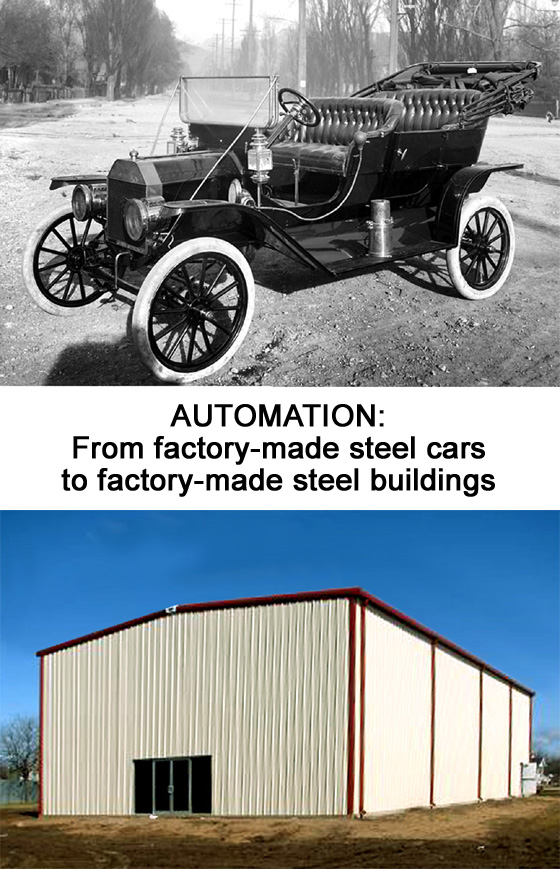Comparing Automotive Automation to Metal Building Production
Have you ever thought about the parallels between cars and steel buildings? Both industries are constantly evolving to bring a better product at a better price to today’s savvy consumer.
Automobiles and Buildings in 1900
 At the beginning of the 20th century, only the very wealthy could afford to own the new “horseless carriages” known as automobiles.
At the beginning of the 20th century, only the very wealthy could afford to own the new “horseless carriages” known as automobiles.
Constructed by skilled craftsmen one at a time, cars were extremely expensive. Complex and prone to breaking down, these first automobiles generally needed professionally trained mechanics and chauffeurs to keep them operating, creating additional expenses.
Construction in the early 20th century was the same. Buildings were produced one at a time at the job site. Professional carpenters and experienced project managers were required. Every piece needed to be measured, cut to the correct length and angle, and nailed into place, one by one.
Sadly, many homes and businesses today are still constructed in this inefficient, old-fashioned way.
Henry Ford and the Assembly Line
In 1903, Henry formed the Ford Motor Company. In 1907, Ford announced his goal to create “a motor car for the great multitude.” The Model T debuted in 1908, with a sticker price of $825-$950.
The Model T was a massive step forward in the automotive industry— but still beyond the budget of most Americans. Ford worked with his top managers to find a way to increase production, thereby decreasing the price.
After several attempts at automating production, efficiency gradually improved. By 1913, Ford’s team had perfected an assembly line operation. Model T prices dropped to $360 by 1916— and to about $260 by the 1920s. The factory churned out the motor cars at an unbelievable rate: one Model T every 93 minutes— compared to the 12 hours originally required to produce one unit.
The popularity of Ford’s “Tin Lizzy” was astounding. By 1918, half of all the cars in the U.S. were Model T’s. Ford’s baffled competitors scrambled to compete.
When Model T manufacturing ceased in 1927, over 15,000,000 of the jaunty little cars had been produced.
Following Ford’s example, many industries concentrated on streamlining production to make goods more affordable. The steel building industry is no exception.
Model-T’s succeeded because they were:
• AFFORDABLE to buy
• SIMPLE to drive
• EASY to operate
Those traits also propel the success of pre-engineered steel buildings. Factory-created metal buildings are:
• AFFORDABLE to buy
• SIMPLE to build
• EASY to maintain
Ford cultivated the farm and ranch market to sell his Model T’s. Farmers looked on automobiles as a necessary business expense, making trips to market faster and more economical.
(Old Henry wasn’t slow in the math department either; he knew farmers made up 38% of the entire U.S. workforce in the early 1900s.)
Farmers were also among the first to accept the metal building concept. They immediately saw the advantages of structures that were attractive, strong, simple to erect, and easy to maintain.
Farmers knew steel buildings spanned farther, lasted longer, and cost less than wood barns and farm buildings. Steel structures also provided extra protection from high winds, condensation, mold, fire, termites, and lightning, than a pole barn or wood-framed building.
Innovations in Prefabricated Metal Buildings
Another advance in automobile production was Ford’s switch to vanadium steel. Adding a small amount of vanadium to the steel-making process increased the tensile strength of the steel, yet made the steel more malleable for producing car parts.
The steel industry today continues to make dramatic technological advances in steel production, emission controls, and recycling rates.
Automation in the steel-making processes has made steel prices more affordable than ever. Today a ton of steel is produced in only 2 man-hours or less. Consequently, steel prices have been far more stable than lumber prices over the decades.
Cutting-edge advances in computer aided steel designing and three-directional engineering continue to improve on the efficiency of manufacturing metal buildings.
Value-added Factory-made RHINO Steel Buildings
Produced in highly automated factories across America, RHINO metal buildings provide sturdy and durable buildings at economical price.
Each structure is designed and manufactured to adhere to all local building codes— and to the preferences of the buyer.
Whatever you can dream, we can supply.
All pieces of the framing are cut, welded, punched, and drilled in a quality-controlled factory. Every piece is labeled for easy identification. Everything is shipped directly to the job site, ready to assemble.
Accessorizing Factory-made RHINO Steel Buildings
Unlike Henry Ford’s Model T, which was only available in black, our steel buildings are highly customizable. (Do you know why all Ford Model T’s were black? It was the only color that would dry fast enough to keep pace with the assembly line.)
RHINO steel buildings are available in any length and up to 480’ feet wide. Eave heights are up to 40’ on a standard order, with even taller structures possible with a custom order.
Choose from many colorful steel roof and wall panels and trim. Reflective cool panels and standing seam options are available.
If your structure needs a different look, tilt-up concrete walls, stone, brick, glass, stucco, or wood may be used for the building exterior.
Additional customizing features include, entry doors, overhead doors, skylights, wall lights, gutters/downspouts, insulation packages, vents, liner panels, and more.
Steel Cars, Steel Buildings
Would you want to drive a car made of wood? Of course not. So why would you want to build with wood?
Please call RHINO today for a free quote on a prefabricated steel building for your next project: 940.383.9566.
